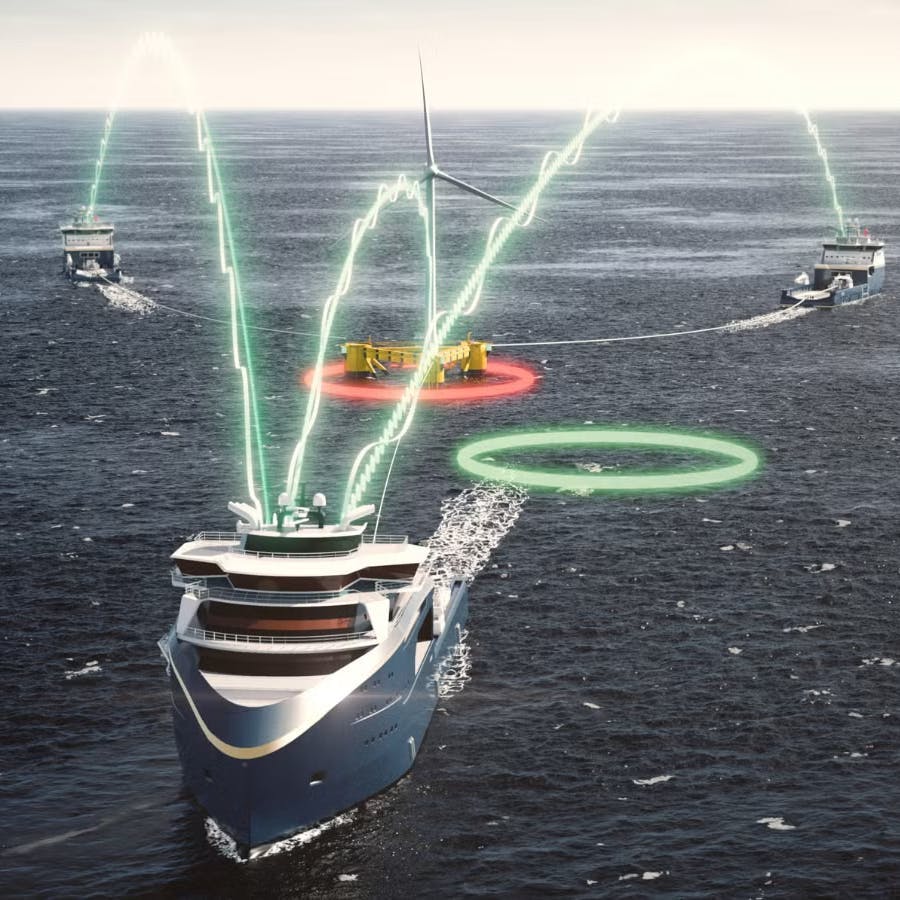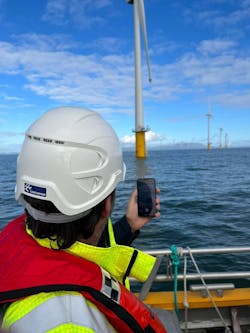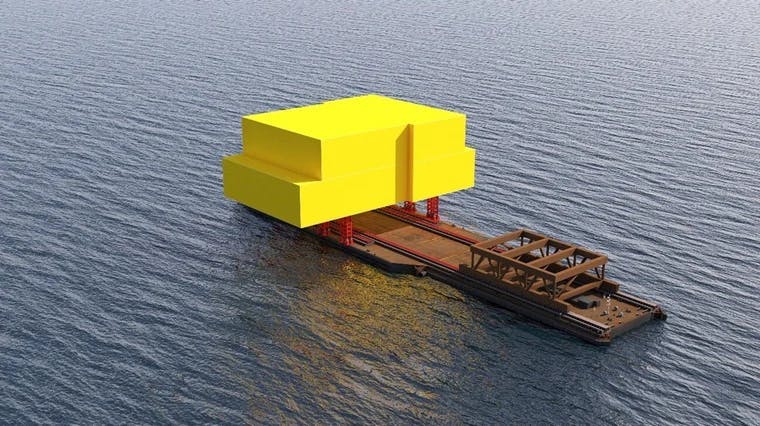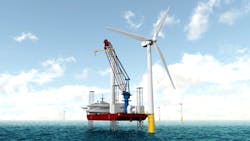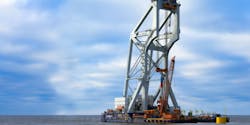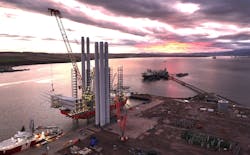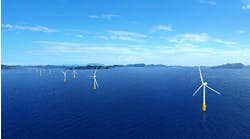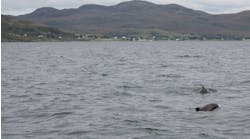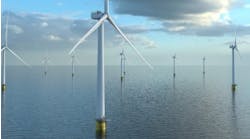Offshore wind round-up: T&I of turbines, exclusion zone monitoring, activity forecast
The start of February saw a heavy volume of offshore wind announcements, and this weekly compilation highlights the news you may have missed recently.
NEW TECHNOLOGIES:
Kongsberg releases floating wind turbine T&I service
The service includes two floating wind installation vessel (FWIV) concepts. The Ulstein-designed anchor handling version (UT 7900 FWIV AH) features a triple cross-tensioning winch system that can tension and proof-load up to three mooring lines simultaneously with reduced bollard pull requirements. It can pull up to 900 metric tons in a single fall configuration.
For transporting giant turbines to offshore fields, the Tow Assist method combines Kongsberg Maritime’s K-Pos DP technology with operations analysis, and it is said to enhance situational awareness and safety through all stages of the towing operation.
The service, trialed successfully last year in the North Sea, involves use of K-Pos to allow unpowered floating structures to become DP-enabled during complex tow-outs through calculating and distributing the optimal allocation of the connected vessels.
Kongsberg Maritime’s integrated tensioning service for mooring line hookup tasks is said to compensate for relative movements between the floater and the vessel, also extending the operational weather window. It employs the company’s permanent magnet, high-torque winches to provide response and motion compensation for tensioning of mooring lines.
Finally, the company has developed a new method for cable pull-in operations, which it claims can reduce requirements for equipment and people on the floater structure, helping to speed up the overall rate of installation.
According to spokesman Gunnar Thorsen, “At present, cable pull-in operations require mobilizing equipment such as winches, power packs and fuel tanks on the floating turbine. Personnel must be on board the floater after it has been hooked up to perform the cable pull-in. With the new method, all necessary equipment is placed on the vessel, significantly reducing the complexity and risk associated with the operation…
“Equipment lifting operations and personnel transfer are minimized, which allows operations to continue in harsher weather conditions. This is crucial for maintaining year-round productivity and speeds up the overall rate of installation of the wind farm array.”
Cognitive Business app provides real-time monitoring of exclusion zones
Cognitive Business has upgraded its vessel tracker app on the Robin Rigg wind farm offshore southwest Scotland. This can now provide real-time monitoring and management of exclusion zones to help address safety issues and can be used, for example, to safeguard repair technicians working on offshore turbines.
Previously Vessel Tracker has been used to record crew transfers and provide data on real-time vessel location movement. It now allows wind farm teams to create and manage exclusion zones for planned maintenance campaigns.
At Robin Rigg control room, teams can use it to set up and enforce exclusion zones. The system continuously tracks vessel activity and activates visual and audio alerts if a ship enters an exclusion zone. These are automatically communicated to the control room and any user with access to the platform.
Spinergie releases offshore wind market intelligence tool
In Paris, Spinergie has released an extended offshore wind forecast and consulting service for its Market Intelligence subscribers.
This is said to provide access to intelligence relevant to clients’ operations. They can use the thousands of data points to make decisions that can help them cut emissions and costs on their projects.
Spinergie’s Offshore Wind Forecast, now extending to 2040 and beyond, provides an outlook for fixed and floating offshore wind projects across all areas including frontier regions, such as India and Brazil, with data on wind resources, environmental conditions, and infrastructure needs.
OFFSHORE EUROPE PROJECT UPDATES:
Heerema invests in float-over barge for TenneT North Sea substations
Heerema Marine Contractors has signed a contract with TenneT to supply a new float-over barge, designed to install the 30,000 mt-plus, 2-GW offshore substations planned in the North Sea to support expansion of the Dutch and German electricity grids.
Heerema's new float-over barge will assist in the installation of ultra-heavy topsides, such as TenneT’s 2-GW topsides, supporting the expansion of renewable energy capacity.
TenneT’s 2-GW program involves standardization and long-term agreements with contractors to de-risk the program. A major component of the 2-GW grid connections are the DC offshore power converters; the company plans to install more than 14 of these in the North Sea.
Consortium signs realization agreement with TenneT for Dutch offshore grid connection
The consortium of pension fund ABP, pension investor APG and wind energy developer SSE has signed a Realization Agreement with Transmission System Operator TenneT for the Dutch offshore grid connection of the IJmuiden Ver Alpha wind farm. The wind farm will be built more than 60 km off The Netherlands coast as the first offshore wind farm to be connected by TenneT according to the new 2-GW direct current standard, and it is expected to be commissioned by the end of this decade. Read more.
Ørsted downsizes near-term offshore wind ambitions
Ørsted’s plans to prioritize more value-accretive growth opportunities going forward, the company said in a trading update.
Last year, the company secured 3.5 GW of new offshore wind capacity in the UK and took FID on the Baltica 2 wind farm in the Polish sector of the Baltic Sea. But there were challenges, notably related to the US offshore wind portfolio. In response, the company has slimmed down its planned investments toward 2030 by 25%. Read more.
First monopile installed at Baltic Power offshore wind farm
The development, due to be completed in 2026, features new-generation, 15-MW offshore wind turbines. Co-developers ORLEN and Northland Power commissioned Van Oord to transport and install 78 foundations, each comprising a monopile fitted with a transition piece.
Among the changes to Svanen, the gantry crane has been extended by 25 m, making it one of the world’s largest heavy-lift installation vessels, according to Van Oord.
Cadeler staying busy with Baltic Sea wind projects
Cadeler has signed a vessel reservation agreement with Ocean Winds concerning installation of about 30 wind turbine generators at the BC-Wind offshore wind farm in the Polish Baltic Sea.
The company will allocate one of its O-class vessels, with work due to be completed in 2028.
BC-Wind, with a capacity of up to 500 MW, is situated 23 km from the coast, north of the Pomeranian Voivoideship. It also marks Ocean Winds' first project in Poland.
Last October, Cadeler signed contracts with the Equinor and Polenergia joint ventures covering installation of two offshore wind farms, Bałtyk 2 and Bałtyk 3, in the Polish Baltic Sea. Operations are due to start in 2027.
By the end of that year, construction operations should have finished at Baltica 2, part of the Baltic Offshore Wind Farm. Cadeler will transport and install the SiemensGamesa 14-MW wind turbines for Ørsted and PGE Polska Grupa Energetyczna.
The company has a further contract with Baltic Power to install 76 Vestas 15-MW wind turbines at the Baltic Power offshore wind farm, with installation work due to start later this year and conclude in 2026.
Construction contracts issued for North Sea Nordlicht wind farms
Vattenfall and BASF have awarded four main contracts for their Nordlicht 1 and 2 offshore wind farm developments in the German North Sea, 85 km north of the island of Borkum. Nordlicht 1 will have a capacity of about 980 MW and Nordlicht 2 about 630 MW. At peak, the two developments should generate close to 6 TWh/year. Pending FID on the projects this year, construction should begin in 2026, with full commissioning and full operations expected by 2028. Read more.
Interocean awarded contract for three offshore wind projects
Interocean Marine Services has a three-year contract to provide marine vetting and assurance to the Morgan, Mona and Morven offshore wind projects. All three are under development by the joint venture between bp and Energie Württemberg AG (EnBW). Morgan and Mona are in the east Irish Sea, and Morven is in the central UK North Sea. Read more.
Acteon completes first year of balance of plant inspection for Siemens
Acteon’s Geoservices division has completed the first year of a three-year balance of plant subsea inspection contract with Siemens Gamesa Renewable Energy (SGRE) for the Butendiek offshore wind farm, which is 32 km west of the island of Sylt in the German North Sea. UTEC performed annual subsea foundation inspections using a combination of ROVs, array cable and foundation seabed surveys, and corrosion protection surveys. Read more.
CSP secures funding to develop offshore coordination center
Celtic Sea Power (CSP) has obtained funding from The Crown Estate’s Supply Chain Accelerator facility to help de-risk development of a new offshore coordination center by CSP and partner Treveth close to Newquay Airport on the north Cornwall coast in southwest England. Read more.
Corvus ESS to power world’s first fully electric offshore vessel
Corvus Energy will deliver what it describes as a “mega-size” battery system for what it says will be the first fully electric offshore vessel ever to be built. The vessel is an electric commissioning service operation vessel (eCSOV) that will be constructed by Armon shipyard in Spain for UK-based shipowner Bibby Marine Ltd.
Corvus Energy says that it will supply its Blue Whale Battery Energy Storage System (BESS), which will deliver close to 25MWh of power for the vessel. It will be the largest LFP (Lithium Iron Phosphate) battery system ever delivered to a maritime project, the company says.
Corvus Energy officials say that this eCSOV will be the first offshore vessel that can operate fully electric for a full day. The vessel design will incorporated both battery power and dual-fuel methanol engines that “will significantly reduce carbon emissions and increase energy efficiency while providing the reliability and performance needed for demanding offshore wind and renewable operations.” Read more.
ASIA-PACIFIC PROJECT UPDATES:
Yunlin wind farm up and running offshore Taiwan
Skyborn Renewables says the Yunlin Offshore Wind Farm in the Taiwan Strait is now fully operational and producing at its design capacity of 640 MW. All 80 wind turbine generators are producing electricity for domestic and business users. The Yunlin farm extends across an 82-sq-km project area, 8 km to 17 km offshore western Taiwan and in water depths from 7 m to 35 m. Read more.
Tidal Transit, partners to develop OSVs for South Korean wind projects
Tidal Transit has signed a memorandum of understanding with Britoil Offshore Services (Singapore) and Sky Offshore (South Korea) to develop and operate offshore support vessels (OSVs) for the South Korean offshore wind sector.
The nation has set a target of 14.3 GW of offshore wind capacity by 2030.
UK-based Tidal Transit operates a fleet of crew transfer vessels to service the offshore wind industry at all project stages, including survey, installation operations, maintenance and decommissioning.
China continues to dominate offshore wind growth
Fully operational offshore wind farms globally have amassed capacity of 80.9 GW, a 15% increase on the total of 70.2 GW a year earlier, according to RenewableUK. Of the newly added capacity, 63% came from China (6.9 GW) and the Netherlands (1.7 GW).
The upward trend will likely continue with the number of projects in the global offshore wind pipeline up from 1,461 to 1,555 over the past 12 months, with 44 countries now involved following recent confirmation of the first offshore wind projects in Chile, Indonesia and Malta. Projects in the works include offshore wind farms at all stages: fully operational, under construction, consented, in the planning system, or in early development.
China dominates with a portfolio of 437 projects with a combined output of 247 GW, while the UK stays second with 96 GW from 123 projects. Read more.
US PROJECT UPDATES:
Shell exits Atlantic Shores offshore wind project
Shell has reportedly exited the Atlantic Shores offshore wind project, saying that the project no longer fits its capabilities or the returns the company expected. Shell has reportedly written off its $1-billion investment in the project.
The Shell decision to “back away” from the project, as reported by the financial services firm Morningstar, came despite the project having received its Construction and Operations Plan approvals from the US Bureau of Ocean Energy Management (BOEM) on Oct. 1, 2024. Read more.

